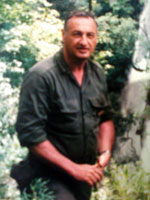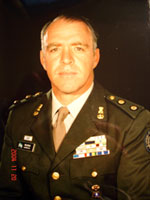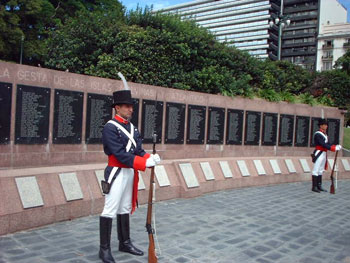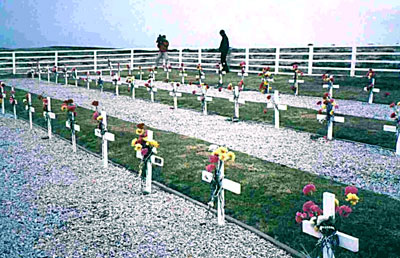| The Falkland / Malvinas Islands have long been a source of friction between Argentina and Britain. The tension escalated on 19 March 1982, when a group of Argentine scrap-metal dealers hired by Argentine businessman, Constantino Davidoff, to dismantle an old whaling base, raised the Argentine flag on South Georgia Island, an uninhabited island 1,287 kilometres northeast of the Falklands / Malvinas. The event ultimately led to the Argentine invasion of the Falklands / Malvinas on 2 April 1982, code-named ‘Operation Rosario’. This action led to a full-scale war with Britain, which ended with Argentina’s surrender on 14 June 1982. In the end, more than one thousand Argentines and two hundred and fifty British lost their lives in the short but bitter conflict.
Many Irish-Argentines fought in the war, either as professional soldiers or as conscripts. Similarly, on the British side, there were also numerous soldiers who were either Irish-born or of Irish descent. It is not possible to ascertain the actual number of Argentine troops of Irish ancestry who participated in the war, but merely focusing on those with Irish surnames would suggest that their representation among the troops was broadly proportionate to the estimated number of Argentines of Irish descent in the general population (approximately 0.7 per cent). Irish-Argentine soldiers contributed in many and varied ways to the conduct of the war. According to Edmundo Murray, ‘translation was one particularly skilled service rendered by many Irish Argentines during the Falkland / Malvinas War’ (Murray 2005: 3:6)
Individual accounts from soldiers who fought in wars can give new insights into the conduct of a war and the execution of military strategy and thereby serve as a valuable tool for the military historian. Below, the testimonies of three Irish-Argentine soldiers who fought in the war are presented, each of which portrayed the first-hand experiences of a particular category of participant: a senior officer, a newly-commissioned officer, and a conscript.
Brigadier-General Eugenio Dalton
|

Eugenio Dalton |
Brigadier-General Eugenio Dalton is a grandson of Thomas Dalton of General López, Santa Fe in the province of Buenos Aires (born in 1843 in Ireland, died in 1925 in Córdoba, Argentina) and Ellen McGann. He joined the Argentine military academy in 1953 and graduated in 1956 as Sub-Lieutenant of the infantry army. In 1974, Major Dalton obtained the title of Staff Officer. Between 1977 and 1978, he attended a course at the Academy of the Armed Forces of the Federal Republic of Germany, together with Commander (Major) Colm Mangan who, in 2000 was promoted to Lieutenant-General and appointed Commander-in-Chief of the Irish defence forces.
In early 1981, at the age of forty-eight and having attained the rank of Lieutenant-Colonel, he was appointed Chief of the Operations Division of the III-X Command of the Mechanised Infantry Brigade, based in the city of La Plata, in the province of Buenos Aires. The command's mission was to prepare officers and conscripts of the units and sub-units to carry out conventional operations who could be deployed on regional missions. After the war, Major Dalton returned to his original command and continued his military career. He was promoted to Colonel in 1982, and promoted to Brigadier-General in 1987. In December 1989, he retired from the army. Following his retirement, he acted as an advisor to the Argentine Senate on national defence issues until 2005.
A Senior Officer’s Story: The War in Dalton’s Words
‘In April 1982, the brigade was training the conscripts who had recently begun their year of compulsory military service. We were fully engaged with this activity and were "surprised" by the events of 2 April 1982 [the initial landing of the Argentine forces in the Falklands / Malvinas]. On 9 April, the brigade was ordered to prepare for airlift to the Falklands / Malvinas. All elements of the brigade, including conscripts from the previous year who had been drafted, were called up to go to the Falklands / Malvinas, except for the Tenth Mechanised Artillery Group, whose armaments were obsolete.
‘The higher rungs of the brigade, of which I was part, were the first to go on 11 April. We took personal equipment, including enough ammunition for a day’s combat. At 19:00 hours we landed at the airport in Port Stanley / Puerto Argentino. The deployment of the whole brigade was completed on 16 April.
‘The field kitchens, water carriers, trailers and light vehicles essential for the preparation and distribution of rations, some jeeps and ammunition for fifteen days of fighting were loaded aboard the ship Formosa and arrived in Port Stanley / Puerto Argentino on 21 April.
‘Already from 2 April, General Benjamín Menéndez, commander of the Argentine troops and military governor of the Falklands / Malvinas, together with his entourage, including the commander of the Ninth Infantry Brigade, General Daher and his staff, had deployed units to defend the Argentine positions: the Twenty-Fifth Infantry Regiment in the airport area; one of his companies from the Ninth Infantry Brigade in Darwin; the Fifth Marine Battalion in Sapper Hill, Tumbledown and Williams; the Eighth Regiment Infantry and the Ninth Society of Engineers in the Fox Bay area. The Air Force with their pucara combat aircraft was based in Port Stanley / Puerto Argentino under the command of Brigadier Luis Castellanos.
‘On 12 April, the commander of the Tenth Mechanized Infantry Brigade, General Oscar Jofre, took over as commander of ground troops in the Falklands / Malvinas. I was part of his staff, and, as the most senior officer, was appointed Chief of the Division III-Operations (G3). It fell to our division to carry out studies and to propose a course of action. The order for the commencement of operations was made on 15 April.
‘On 24 April, with the arrival of the Third Infantry Brigade and other troops to the islands, it was decided to divide the islands into two sectors. One of the sectors included the Puerto Argentino / Stanley area, the Fressinet peninsula and Port Louis (the Puerto Argentino / Stanley group). The other sector included Darwin, Goose Greens, Port Howard and Fox Bay.
‘The command post of the army’s Puerto Argentino / Stanley Group was initially installed at Moody Brook, once the headquarters of the Royal Marines, which was later destroyed by the British during aerial bombardment. Before the attacks, the command post had been moved to Stanley House in Port Stanley / Puerto Argentino.
‘The battle for the Falklands / Malvinas can be split into two phases: the first between 1 and 20 May, which was predominantly aerial, and the second from 21 May to 14 June, which was mainly terrestrial. In the first stage, we had no alternative but to play a game of “wait-and-see” for the British air and naval actions. We reacted from our positions with the modest means at our disposal to neutralise the British attacks, and waited for the Argentine Air Force based in the mainland to strike at the British fleet.
‘In the second phase, we fought against the British attack insofar as we could, given that we were faced with their superiority, isolation, lack of resources, difficult terrain, poor weather conditions and the aerial attacks we were subjected to throughout the campaign.
‘If I were to explain the list of tasks we carried out during the campaign, it would be a very extensive list indeed, but I can attest that the commander of the Port Stanley / Puerto Argentino Group worked extremely hard, with very little rest or relaxation, and, in my case, from the operations tactical centre, mindful of anything that could happen in the area of operations.
‘On 14 June, the ceasefire happened and the Argentine forces surrendered. On 17 June, I was transferred by helicopter with other prisoners of war from Port Stanley / Puerto Argentino to a disused refrigeration plant at Ajax Bay, where we stayed until 30 June, when we boarded the ship St. Edmund which was docked in Berkeley Sound. On 13 June, we were told that the ship would be sailing to the mainland and on 14 June, we landed in Puerto Madryn in the province of Chubut. At all times we received considerate treatment by the British forces.’
Colonel Leandro Luis Villegas
|

Leandro L. Villegas |
Colonel Leandro Luis Villegas is the grandson of Santiago Farrell, who managed the estancia of Siete Arboles in General López, in the province of Santa Fe, Argentina, on behalf of an Irish-descended landowner, Patricio Cunningham (1861-1947). Farrell’s parents had emigrated from Ireland and settled in Venado Tuerto, Santa Fe. Colonel Villegas graduated from the National Military Academy in December 1981 as a Sub-Lieutenant of the Armoured Engineers and, in January 1982, was posted to his first unit, the Ninth Company of Engineers, based in Sarmiento in Chubut.
A Newly-Commissioned Officer’s Story: The War in Villegas’ Words
‘After finishing instruction on the basic training course for the recent intake of conscripts, we met on 25 March with our head officer, Major Minorini Lima. We were asked to take an oath to not divulge to anyone what he was going to say to us. He gave us the order to prepare our unit to join with the Twenty-Fifth Infantry Regiment, commanded by Lieutenant-Colonel Seineldin, to partake in the invasion of the Falklands / Malvinas.
‘Naturally we were surprised by the news. Immediately we began preparations to go to Comodoro Rivadavia and then fly to the Falklands / Malvinas. We landed in Port Stanley / Puerto Argentino on 2 April at approximately 08:45 hours. We stayed at the airport until late afternoon, where we were given orders to board the ship Isla de los Estados to be taken to Fox Bay. On boarding the ship, we received the news of the death of Lieutenant Giacchino, the first Argentine fatality in the war. On the journey to Fox Bay East, I shared part of the trip with Lieutenant Estebes, who disembarked at Goose Green. He would later lose his life there, in a battle with the Second British parachute regiment.
‘My role in my unit was Chief of Combat Engineers section. On arrival in Fox Bay East, we set up positions on the southwestern part, covering a large beach side village of two kilometres in length. We immediately set about shoring up our positions until 1 May, when we first came under attack. Our position was persistently shelled by the frigates. Thank God we did not suffer serious casualties. As an engineering company, a key part of our job was laying mines along our front line and giving advice to other infantry units on how to install them.
‘An interesting story is how the soldiers built pseudo-weapons (for example, anti-aircraft guns) by using the wheels of scrap cars and sewer pipes that civilians had in their garages. The activity was undertaken at night to avoid being observed. It annoyed me as, at the time, I didn’t think they would be useful. But time showed me otherwise, as on many occasions they drew enemy fire. After the war, the British were very surprised that some of coastal defences comprised pseudo-weapons.
‘As a younger officer I was proud to carry the flag of the unit. The flag was about to be burned before surrendering, but I took the decision to hide it in my spare underwear. Following our release as prisoners of war and repatriation to Argentina on the ship, the Norland, I discovered it and removed it on landing in the mainland.
‘Our treatment as prisoners of war was humane but tough, but as I was twenty-one years old and a professional soldier, it did not affect me that greatly. The great disappointment was not being able to retain the islands and the great loss in human life.’
Carlos Connell
|

Carlos Connell |
Carlos Connell was born in Berisso near La Plata, in the province of Buenos Aires. He is the son of Carlos Esteban Connell, of Irish descent, and Nelida Arun, of Syrian-Lebanese descent. His grandfather, Thomas Connell, and grandmother, Maria Luisa MacAdden, moved to Berisso from Capitán Sarmiento, one of the principle areas of Irish settlement in the province of Buenos Aires. Following graduation from high school in 1980, Connell carried out his civic responsibilities and entered training with the Seventh Mechanised Infantry Regiment in the city of La Plata. Conscription was not abolished in Argentina until 1994, under the presidency of Carlos Menem. He finished his compulsory military service at the end of 1981 and was just about to start a university degree in engineering, when he was called up for service following the outbreak of war in the South Atlantic. He should have been exempt from further service, but because the latest batch of conscripts had not been fully trained, the previous year’s intake was recalled.
On his return from the war, Carlos helped found a veterans centre in La Plata, known as the Centro de Ex-Combatientes Islas Malvinas (CECIM), which assists veterans in finding jobs, accessing state services and securing affordable housing. CECIM is also active on the human rights front by searching for military commanders who mistreated common soldiers. Some officers have already been indicted for such crimes.
A Conscript’s Story: The War in Connell’s Words
‘On Thursday 13 April 1982, we left La Plata for the Falklands / Malvinas, arriving three days later. I was immediately posted to Mount Longdon, a location of strategic importance, northwest of Port Stanley. I spent the whole war there, until 12 June, when we retreated after heavy fighting. We continued fighting until the final surrender of 14 June, after which we were repatriated to Argentina by the British ship Continental Canberra.
‘From my impression, the landscape of the Falklands / Malvinas is similar to Ireland, particularly the rock types and the vegetation, but maybe the elevations are not as high as those of Ireland. Mount Longdon is a small rocky outcrop, about 150 metres above sea level, located at twelve to fourteen kilometres towards the northwest of Port Stanley / Puerto Argentino.
‘I was a member of Company B of the Seventh Infantry Regiment, and we were supported by a group of the Tenth Regiment of Engineers and an anti-aircraft group of the Fifth Marine Battalion. In total, there were three hundred and ten troops stationed there. Our aim was to form part of a defensive cordon around Port Stanley / Puerto Argentino, the only really important city of the islands.
|

Memorial to those who died in
the Falklands / Malvinas War.
Plaza San Martín, Buenos Aires |
‘The seventy days we spent on Mount Longdon were very challenging. We lived in small tents which accommodated two soldiers. With each passing day, the situation got worse. As the winter wore on, our provisions began to run out. We received more and more British naval bombardment, and we had no change of clothing. Our clothing was usually damp. It really weakened us. To add to the misery, many soldiers were mistreated by their superiors. We had no running water: we had to resort to drinking water from the pools that formed between the rocks. We didn’t have good communication with our families, and our weapons were not great and in some cases inoperable.
‘Against this background, on 11 June, the engagement with the British troops took place on Mount Longdon. We were attacked by the Third British parachute regiment at nightfall as we were going to bed. The battle started on the west where we were based, and we fought in hand-to-hand combat with the British troops. It was a tough night. We fought from about 21:00 until the following morning. There were many casualties on both sides. Met by fierce resistance, the British troops pulled back from the western sector of Mount Longdon to re-group. Following the battle of Mount Longdon, there was a major shift in British strategy. From there on in, the British resorted to artillery attacks by land, sea and air. Our regiment and other Argentine regiments were incessantly bombarded from land, sea and air. Amusingly, we were told to avoid using surnames like mine, for fear that the enemy thought we had taken British prisoners. I was lucky enough to return unscathed.
‘In May 2007, on the twenty-fifth anniversary of the war, I went back to the Falklands / Malvinas with a group of eight other Argentine veterans. I had a strong desire to revisit the scene of the battles, and I felt a strong sense of belonging to the islands. Accompanied by a TV crew we toured Port Stanley / Puerto Argentino, where we visited the Argentine war cemetery and other landmarks.’
John Kennedy
Notes
1 (1) I owe a big debt of gratitude to Hugo Cormick, Sub-secretary for Coordination at the Argentine Ministry of Defence for all his help, to Colonel Claudio Montero of the Argentine Army and to Captain Hugo Morris of the Argentine Navy. I am also extremely grateful to Ronnie Quinn and veterans’ organisations CECIM - La Plata and the Fundación Veteranos de Guerra de Malvinas.
References
-Andrada, Benigno Héctor, Guerra aérea en las Malvinas (Buenos Aires: Emecé
Editores, 1983).
-Balza, Martín, Malvinas: Gesta e Incompetencia (Buenos Aires: Atlántida, 2003).
-Bishop, Patrick Joseph and Witherow, John, The Winter War: The Falklands (London:
Quartet Books, 1982).
-Burns, Jimmy, The land that lost its heroes: how Argentina Lost the Falklands War (London: Bloomsbury, 2002).
-Cerón, Sergio, Malvinas: ¿gesta heroica o derrota vergonzosa? (Buenos Aires:
Editorial Sudamericana, 1984).
-Díaz de Molina, Alfredo, Las Islas Malvinas y una nueva diplomacia (Buenos Aires:
Editorial Platero, 1976).
-Esteban, Edgardo and Borri, Gustavo Romero, Iluminados por el fuego: confesiones de
un soldado que combatió en Malvinas (Buenos Aires: Editorial Sudamericana,
1993).
-Etchepareborda, Roberto, ‘La bibliografía reciente sobre la cuestión Malvinas’ in
Revista Interamericana de Bibliografía / Inter-American Review of Bibliography 34:1 (1984): pp. 1-52.
-----, ‘La cuestión Malvinas en perspectiva histórica: historia de las controversias
del siglo XVI hasta nuestros días’ in Revista de Historia de América 96 (Julio-Diciembre 1983): pp. 27-67.
-The Falklands War: The Official History (London: Latin American Newsletters, 1983).
-Fitte, Ernesto J., ‘Las Malvinas bajo la ocupación británica’ in Investigaciones y
Ensayos [Academia Nacional de la Historia., Argentina] 6-7 (1969): pp. 63-87.
-Fitz-Gibbon, Spencer, ‘Not mentioned in despatches’: The History and Mythology of
the Battle of Goose Green (Cambridge, England: Lutterworth Press, 1995).
-Foulkes, Haroldo, Malvinas: 74 días alucinantes en Puerto Argentino (Buenos Aires:
Corregidor, 1984).
-Fox, Robert, Eyewitness Falklands: A Personal Account of the Falklands Campaign (London: Methuen, 1982).
-Hanrahan, Brian and Fox, Robert, ‘I counted them all out and I counted them all
Back’: The Battle of the Falklands (London: British Broadcasting Corporation, 1982).
-Hoffmann, Fritz Leo and Hoffman, Olga Mingo, Sovereignty in Dispute: The
Falklands / Malvinas, 1493-1982 (Boulder: Westview Press, 1984).
-Kon, Daniel, Los Chicos de la Guerra: hablan los soldados que estuvieron en Malvinas (Buenos Aires: Editorial Galerna, 1982).
-Menéndez, Mario Benjamín and Túrolo, Carlos M., Malvinas: testimonio de su
gobernador (Buenos Aires: Editorial Sudamericana, 1983).
-Moneta, Carlos J., ‘The Malvinas Conflict: Analyzing the Argentine Military Regime's
Decision-making Process’ in Latin American Nations in World Politics (Heraldo Muñoz and Joseph S. Tulchin, eds). Boulder: Westview Press,(1984), pp.19132.
-Murray, Edmundo ‘The Irish in Falkland / Malvinas Islands’ in Irish Migration Studies
in Latin America (IMSLA), 3:6 (November-December 2005).
-Repetto, Roberto, ‘Las Malvinas: nuestros títulos históricos y jurídicos’ in Revista de la
Junta de Estudios Históricos de Mendoza 10 (Agosto 1984): pp. 443-448.
-Rozitchner, León, Las Malvinas: de la guerra ‘sucia’ a la guerra ‘limpia’ (Buenos
Aires: Centro Editor de América Latina, 1985).
-Sunday Express Magazine Team, War in the Falklands: The Campaign in Pictures (London: Weidenfeld and Nicolson, 1982).
-Túrolo, Carlos M., Así lucharon (Buenos Aires: Editorial Sudamericana, 1982).
-Waispek, Carlos Alberto, Balsa 44: relato de un sobreviviente del crucero A.R.A.
General Belgrano (Buenos Aires: Editorial Vinciguerra, 1994).
-Ward, Sharkey, Sea Harrier over the Falklands: A Maverick at War (Annapolis, Maryland: Naval Institute Press, 1992).
|





